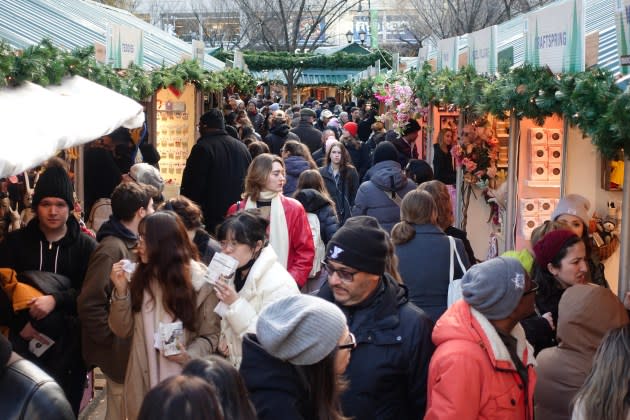Holiday Report Card: Retail Up 3.1 Percent, on Plan

Though as picky and discount-driven as ever, consumers shopped enough over the course of the season to enable retailers to come out with low-single-digit sales gains, meeting expectations.
U.S. retail sales increased 3.1 percent year-over-year this holiday season, according to preliminary insights from Mastercard SpendingPulse released Tuesday.
More from WWD
EXCLUSIVE: Circana Data Shows General Merchandise Holiday Sales Decline
How the Royal Family Styled King Charles' Highgrove Heritage Scarf for Christmas
Holiday Wrap: Retailers Overcome Uncertainties, Sales Meet Expectations
Mastercard’s findings are based on in-store and online retail sales across all forms of payment for the Nov. 1 to Dec. 24 period. The figures exclude automotive sales and are not adjusted for inflation, which in the U.S. was 3.1 percent as of last November.
“This holiday season, the consumer showed up, spending in a deliberate manner,” Michelle Meyer, the chief economist at the Mastercard Economics Institute, said in a statement Tuesday. “The economic backdrop remains favorable with healthy job creation and easing inflation pressures, empowering consumers to seek the goods and experiences they value most.”
The whole story on both holiday sales and profits won’t be learned until February and March, when major retailers issue their fourth-quarter results. The National Retail Federation projects a 3 to 4 percent year-over-year growth in sales during November and December, excluding inflation, translating to a spending range of $957.3 billion to $966.6 billion.
During holiday 2023, retailers were aided by weather that was largely dry, unseasonably warm and favorable for driving to malls, and by the calendar, with “Super Saturday” falling two days before Christmas, giving consumers a whole weekend before the holiday for last-minute gift shopping. in addition, retailers unleashed holiday campaigns and promotions as far back as October, stretching out the season.
According to MRI Software, a real estate technology firm that tracks footfall, on Super Saturday, pedestrian traffic in New York City was up 0.7 percent from Super Saturday in 2019. In major downtowns across the U.S., Super Saturday traffic was down 9.1 percent from Super Saturday in 2019.
Year-over-year, Super Saturday traffic was up 54.7 percent in New York City from Super Saturday 2022, and up 60.6 percent in downtown locations in major cities from Super Saturday 2022. Those big percent jumps were largely due to the calendar shift.
“This year’s holiday calendar supported last-minute shopping, with Super Saturday falling on the day before Christmas Eve, in contrast to last year’s Super Saturday, which took place on Dec. 17. Christmas Eve in 2022 fell on a Saturday,” whereas this year it fell on a Sunday, explained Cederick Johnson, MRI Software’s senior director, brand and communications.
“Yet the calendar only partly explains the significant increases in pedestrian traffic on Super Saturday, both nationally and in New York City downtowns,” Johnson added. “The jumps are encouraging, as is the comparison between New York City’s downtown traffic in 2023 and 2019. The latter data indicates that one of the world’s busiest shopping meccas is returning to pre-pandemic norms.
“Although the week beginning on Dec. 17 got off to a slow start, last-minute shoppers more than compensated for the early lag as Christmas neared. Any retailers that catered to them by hosting events or offering special discounts likely enjoyed a strong return on investment.”
Breaking down some key retail trends for the 2023 holiday season, Mastercard indicated:
Online retail sales increased 6.3 year-over-year while in-store sales rose a more modest 2.2 percent, year-over-year. “Spending online is increasing at a faster pace than in-store, therefore taking a growing slice of the retail pie, but shopping in-store still makes up a considerably larger portion of total retail spending,” Mastercard indicated.
Apparel, up 2.4 percent year-over-year, was a top category this season as consumers shopped for new outfits and upcoming holiday festivities.
The restaurant sector was up 7.8 year-over-year, while grocery was up 2.1 percent for the season.
“Retailers started promotions early this season, giving consumers time to hunt for the best deals and promotions,” said Steve Sadove, senior adviser for Mastercard and former chief executive officer and chairman of Saks Inc. “Ultimately it was about getting the most bang for your buck as consumers spent on a variety of goods and services, resurfacing spending trends from before the pandemic.”
“
Best of WWD
